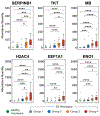A proteomic analysis of NETosis in trauma: Emergence of serpinB1 as a key player
- PMID: 36730076
- PMCID: PMC9974543
- DOI: 10.1097/TA.0000000000003849
A proteomic analysis of NETosis in trauma: Emergence of serpinB1 as a key player
Abstract
Background: Release of neutrophil extracellular traps (NETosis) may mediate postinjury organ dysfunction, but mechanisms remain unclear. The intracellular serine protease inhibitor (serpin) B1 is vital to neutrophil function and has been shown to restrict NETosis in inflammatory settings. In this study, we used discovery proteomics to identify the proteomic signature of trauma-induced NETosis. We hypothesized that serpinB1 would be a major component of this NET protein profile and associated with adverse outcomes.
Methods: This was a post hoc analysis of data collected as part of the COMBAT randomized clinical trial. Blood was collected from injured patients at a single Level I Trauma Center. Proteomic analyses were performed through targeted liquid chromatography coupled with mass spectrometry. Abundances of serpinB1 and known NETosis markers were analyzed with patient and injury characteristics, clinical data, and outcomes.
Results: SerpinB1 levels on emergency department (ED) arrival were significantly correlated with proteomic markers of NETosis, including core histones, transketolase, and S100A8/A9 proteins. More severely injured patients had elevated serpinB1 and NETosis markers on ED arrival. Levels of serpinB1 and top NETosis markers were significantly elevated on ED arrival in nonsurvivors and patients with fewer ventilator- and ICU-free days. In proteome-wide receiver operating characteristic analysis, serpinB1 was consistently among the top proteins associated with adverse outcomes. Among NETosis markers, levels of serpinB1 early in the patient's course exhibited the greatest separation between patients with fewer and greater ventilator- and ICU-free days. Gene Ontology analysis of top predictors of adverse outcomes further supports NETosis as a potential mediator of postinjury organ dysfunction.
Conclusion: We have identified a proteomic signature of trauma-induced NETosis, and NETosis is an early process following severe injury that may mediate organ dysfunction. In addition, serpinB1 is a major component of this NET protein profile that may serve as an early marker of excessive NETosis after injury.
Copyright © 2022 American Association for the Surgery of Trauma.
Conflict of interest statement
Figures





References
-
- Injuries and violence [Internet]. Who.int. World Health Organization; 2021. [cited 2022 Jul 17]. Available from: https://www.who.int/news-room/fact-sheets/detail/injuries-and-violence
-
- Hazeldine J, Hampson P, Lord JM. The impact of trauma on neutrophil function. Injury. 2014;45(12):1824–33 - PubMed
Publication types
MeSH terms
Substances
Grants and funding
LinkOut - more resources
Full Text Sources
Molecular Biology Databases
Miscellaneous

